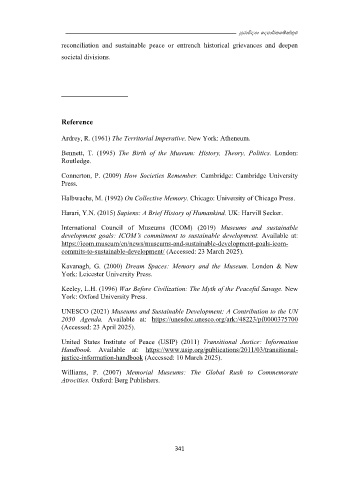Page 362 - Proceedings book
P. 362
mqrdúoHd fomd¾;fïka;=j
reconciliation and sustainable peace or entrench historical grievances and deepen
societal divisions.
Reference
Ardrey, R. (1961) The Territorial Imperative. New York: Atheneum.
Bennett, T. (1995) The Birth of the Museum: History, Theory, Politics. London:
Routledge.
Connerton, P. (2009) How Societies Remember. Cambridge: Cambridge University
Press.
Halbwachs, M. (1992) On Collective Memory. Chicago: University of Chicago Press.
Harari, Y.N. (2015) Sapiens: A Brief History of Humankind. UK: Harvill Secker.
International Council of Museums (ICOM) (2019) Museums and sustainable
development goals: ICOM’s commitment to sustainable development. Available at:
https://icom.museum/en/news/museums-and-sustainable-development-goals-icom-
commits-to-sustainable-development/ (Accessed: 23 March 2025).
Kavanagh, G. (2000) Dream Spaces: Memory and the Museum. London & New
York: Leicester University Press.
Keeley, L.H. (1996) War Before Civilization: The Myth of the Peaceful Savage. New
York: Oxford University Press.
UNESCO (2021) Museums and Sustainable Development: A Contribution to the UN
2030 Agenda. Available at: https://unesdoc.unesco.org/ark:/48223/pf0000375700
(Accessed: 23 April 2025).
United States Institute of Peace (USIP) (2011) Transitional Justice: Information
Handbook. Available at: https://www.usip.org/publications/2011/03/transitional-
justice-information-handbook (Accessed: 10 March 2025).
Williams, P. (2007) Memorial Museums: The Global Rush to Commemorate
Atrocities. Oxford: Berg Publishers.
341

